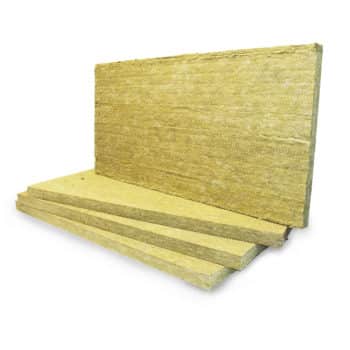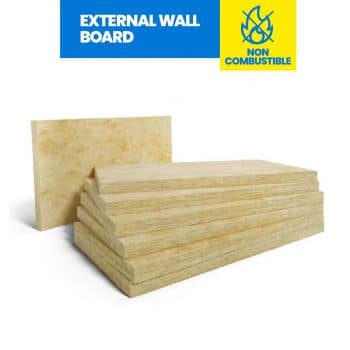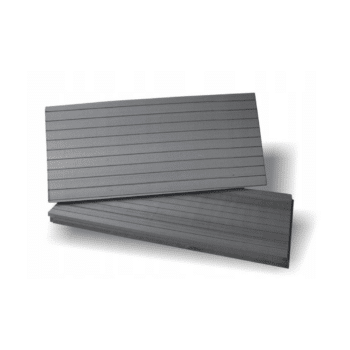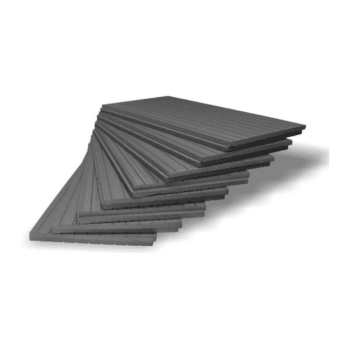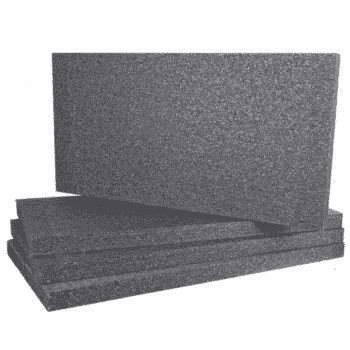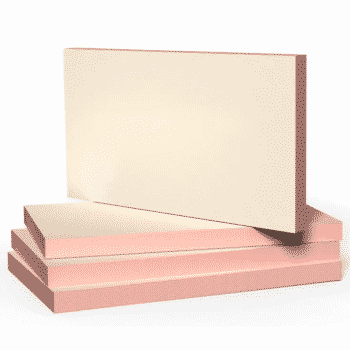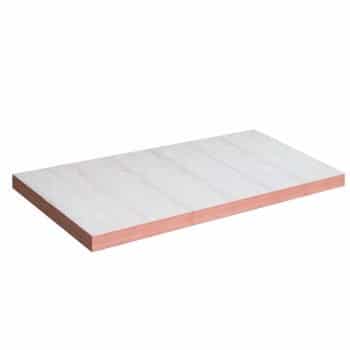What is Compression Strength for Insulation?
Insulation materials are a critical component of the building fabric, regulating the thermal capabilities, enhancing energy efficiency, and even offering acoustic shielding. However, they also improve the durability of the building fabric. The primary contributory characteristic that provides this is compression strength. In today’s blog, we’ll discuss compression strength, why it’s essential for insulation materials, and some of the best-performing materials.
What is compression strength?
Compression strength is the maximum load/capacity something can withstand before it reaches 10% relative deformation. Compression is a force that pushes the particles of a material closer together. This characteristic is essential because it impacts the material’s ability to maintain its form, functionality, and effectiveness under pressure. For insulation, compression strength is critical because it influences how the material performs under a building’s structural loads and during its lifespan.
Measuring compression strength
The measurement of compression strength is typically conducted through standardised tests where a sample of the material is subjected to increasing loads until it deforms or fails. This is quantified in terms of pressure, usually expressed in pascals (Pa) or sometimes in pounds per square inch (psi). For insulation materials, the testing standards might include:
- ASTM C165: This standard test method for measuring the compressive properties of thermal insulations determines the maximum compressive strength and deformation of the material under a compressive force. It is widely used for various insulation types.
- ISO 844: This test measures the compressive properties of rigid cellular plastics, including some foam insulation types.
What determines a material’s compression strength?
- Material density: Generally, higher-density materials tend to have higher compression strength. For example, high-density spray foam or extruded polystyrene (XPS) foam typically exhibits greater compression strength than lower-density alternatives like expanded polystyrene (EPS).
- Material composition: The chemical and physical structure of the insulation material also plays a significant role. Fibreglass, for instance, consists of fine glass fibres that can offer moderate compression strength, whereas materials like cellulose might compress more readily under the same load.
- Moisture content: The presence of moisture can significantly reduce the compression strength of insulation materials. Moist materials are more prone to deformation under load, impacting their structural integrity and thermal performance.
- Age and condition: Over time, materials can degrade or settle, especially under continuous load or exposure to environmental factors, which can diminish their original compression strength.
Why is it important?
The significance of compression strength in insulation goes beyond the material’s physical robustness; it directly impacts the insulation’s efficacy, durability, and overall performance in various structural contexts.
Effective thermal performance
The primary function of insulation is to reduce thermal transfer, helping maintain a consistent internal environment and enhancing energy efficiency. The compression strength of insulation is vital because if the material compresses under the weight of structural elements or due to external pressures, its thickness—and consequently its thermal resistance or R-value—diminishes. For instance, insulation compressed under a heavy load will lose not only its original thickness but also its ability to resist heat flow effectively. This reduction can lead to increased energy costs and reduced comfort levels within the building. Ensuring that insulation retains its designated thickness through adequate compression strength is, therefore, essential for achieving the desired thermal performance over the lifespan of the building.
Structural integrity and load distribution
In areas like roofing and flooring, where insulation might need to bear or distribute loads, its compression strength ensures it can withstand such stresses without deforming. Insulation materials with high compression strength help maintain the structural integrity of these areas by distributing loads evenly and reducing the risk of structural damage. This is particularly important in flat roofs or decks where insulation serves as an integral part of the load-bearing structure. The ability of insulation to handle these loads without significant compression ensures the longevity and durability of both the insulation and the structural elements it supports.
Longevity and material durability
Insulation that can resist compressive forces is less likely to break down or degrade over time. This durability is crucial in environments where the material might be subjected to ongoing stress, such as in high-traffic areas or beneath mechanical equipment. Insulation with higher compression strength is also better at resisting damage during installation and maintenance activities, which can often compromise the material’s integrity. By choosing appropriate insulation, building owners can reduce the need for frequent replacements and maintenance, thereby lowering long-term costs and enhancing the building’s performance.
Versatility in application
Different building areas and types of construction require varying levels of compression strength. Understanding the compression strength of insulation allows architects and builders to choose the right materials for each application, ensuring that the insulation performs well under the specific conditions of each site. For example, beneath a concrete floor slab, a high-compression strength material like extruded polystyrene (XPS) might be necessary to handle the substantial load, whereas, in wall cavities, lighter, less compressive materials might suffice. This tailored approach to selecting insulation based on its compression strength allows for optimised performance across different building parts.
Relationship between material density and compressive strength
Generally, as a material’s density increases, so does its ability to withstand compressive forces. Density refers to the amount of mass per unit volume of a material and is a direct indicator of how compact the material’s structure is. In denser materials, particles or fibres are packed more tightly together, contributing to their ability to resist deformation under compressive loads. The compact arrangement allows the material to distribute applied forces more effectively throughout its structure, thereby enhancing its strength and stiffness. Mineral wool is particularly interesting in composition:
“The thermal insulation products made of mineral wool depending on the orientation of fibres could be di vided into the chaotic (the case when fibres are distributed randomly and in different directions irregularly) and the directional (the case when fibres are distributed in a certain order) [1, 2] in terms of the structure. The mineral wool products which have the directional fibres structure are called “lamella” [3]. Moreover, some products of the combinative fibres structure are used for certain constructions [4]. […] However, as construction practice shows, the contractors are often complaining about the irregular compressive stress (compressive strength) and deforma- tion of slabs used for facade and roof thermal insulation. The assumption may be made that the compressive strength and other mechanical properties of mineral wool products depend on fibre distribution (orientation) in theproduct structure”Buska, Andrius & Mačiulaitis, Romualdas. (2007). The compressive strength properties of mineral wool slabs: Influence of structure anisotropy and methodical factors. Journal of Civil Engineering and Management – J CIV ENG MANAG. 13. 10.1080/13923730.2007.9636425, accessed at https://www.researchgate.net/publication/228675436_The_compressive_strength_properties_of_mineral_wool_slabs_Influence_of_structure_anisotropy_and_methodical_factors
Higher density generally correlates with higher compressive strength for many materials, including metals, polymers, and insulation like foam or fibreglass. This is because the internal structure of denser materials can better support and distribute the stresses associated with compression. When a material is compressed, the individual particles or fibres resist the forces. The denser arrangement provides less space for these particles or fibres to move or buckle, thereby increasing the material’s resistance to compression.
Compression strength of different insulation materials
Most materials’ relative compressive strengths are listed in their technical documentation. Insulation is no different; we currently stock EPS, mineral wool, Kingspan K5, and XPS.
| Insulation | Compression strength | Thermal conductivity | Thickness required to achieve 0.3W/m²K |
| EPS | 70kPa | 0.032 W/(m²K) | 90mm |
| Mineral wool | 10kPa | 0.036 W/(m²K) | 110mm |
| Kingspan K5 | 120kPa | 0.021 W/(m²K) | 60mm |
| XPS | 300kPa | 0.031 – 0.034 W/(m²K) | 90-100mm |
| Wood fibre | 200kPa | 0.038 W/(m²K) | 120mm |
| Sheep wool | 150kPa | 0.035 W/(m²K) | 110mm |
-
Rockwool External Wall Dual Density Slab
Rated 5.00 out of 5From £26.24 Incl. VATFrom £21.87 Excl. VAT -
XPS Insulation (1 board)
From £20.38 Incl. VATFrom £10.20 Incl. VATFrom £8.50 Excl. VAT -
EPS Insulation (1 board = 0.72m²)
Rated 5.00 out of 5From £141.9 Incl. VATFrom £2.39 Incl. VATFrom £1.99 Excl. VAT -
Kingspan Kooltherm K5 External Wall Board (0.72m²)
Rated 4.67 out of 5From £11.99 Incl. VATFrom £9.99 Excl. VAT
With XPS primarily insulating below the DPC, the most durable material we stock is Kingspan K5. For this reason, we call it a space-saving system, as it achieves exceptional durability and thermal performance at a much lower thickness. Building regulations dictate that retrofits must achieve a U-value of 0.3W/m²K, which Kingspan K5 achieves at a thickness of 60mm. The increased compressive strength also makes it suitable for urban areas where mechanical compression and damage can occur.
Facebook
Twitter
LinkedIn
Your cart
Trade Account Login

We use cookies on our website to give you the most relevant experience by remembering your preferences and repeat visits. By clicking “Accept All”, you consent to the use of ALL the cookies. However, you may visit "Cookie Settings" to provide personalised consent.
Manage consent
Privacy Overview
This website uses cookies to improve your experience while you navigate through the website. Out of these, the cookies that are categorized as necessary are stored on your browser as they are essential for the working of basic functionalities of the website. We also use third-party cookies that help us analyze and understand how you use this website. These cookies will be stored in your browser only with your consent. You also have the option to opt-out of these cookies. But opting out of some of these cookies may affect your browsing experience.
Necessary cookies are absolutely essential for the website to function properly. These cookies ensure basic functionalities and security features of the website, anonymously.
| Cookie | Duration | Description |
|---|---|---|
| __stripe_mid | 1 year | This cookie is set by Stripe payment gateway. This cookie is used to enable payment on the website without storing any patment information on a server. |
| __stripe_sid | 30 minutes | This cookie is set by Stripe payment gateway. This cookie is used to enable payment on the website without storing any patment information on a server. |
| _GRECAPTCHA | 5 months 27 days | This cookie is set by the Google recaptcha service to identify bots to protect the website against malicious spam attacks. |
| apbct_cookies_test | session | CleanTalk sets this cookie to prevent spam on comments and forms and act as a complete anti-spam solution and firewall for the site. |
| apbct_page_hits | session | CleanTalk sets this cookie to prevent spam on comments and forms and act as a complete anti-spam solution and firewall for the site. |
| apbct_prev_referer | session | Functional cookie placed by CleanTalk Spam Protect to store referring IDs and prevent unauthorized spam from being sent from the website. |
| apbct_site_landing_ts | session | CleanTalk sets this cookie to prevent spam on comments and forms and act as a complete anti-spam solution and firewall for the site. |
| apbct_site_referer | 3 days | This cookie is placed by CleanTalk Spam Protect to prevent spam and to store the referrer page address which led the user to the website. |
| apbct_timestamp | session | CleanTalk sets this cookie to prevent spam on comments and forms and act as a complete anti-spam solution and firewall for the site. |
| apbct_urls | 3 days | This cookie is placed by CleanTalk Spam Protect to prevent spam and to store the addresses (urls) visited on the website. |
| AWSALBCORS | 7 days | This cookie is managed by Amazon Web Services and is used for load balancing. |
| cookielawinfo-checkbox-advertisement | 1 year | Set by the GDPR Cookie Consent plugin, this cookie is used to record the user consent for the cookies in the "Advertisement" category . |
| cookielawinfo-checkbox-analytics | 11 months | This cookie is set by GDPR Cookie Consent plugin. The cookie is used to store the user consent for the cookies in the category "Analytics". |
| cookielawinfo-checkbox-functional | 11 months | The cookie is set by GDPR cookie consent to record the user consent for the cookies in the category "Functional". |
| cookielawinfo-checkbox-necessary | 11 months | This cookie is set by GDPR Cookie Consent plugin. The cookies is used to store the user consent for the cookies in the category "Necessary". |
| cookielawinfo-checkbox-others | 11 months | This cookie is set by GDPR Cookie Consent plugin. The cookie is used to store the user consent for the cookies in the category "Other. |
| cookielawinfo-checkbox-performance | 11 months | This cookie is set by GDPR Cookie Consent plugin. The cookie is used to store the user consent for the cookies in the category "Performance". |
| ct_checkjs | session | CleanTalk–Used to prevent spam on our comments and forms and acts as a complete anti-spam solution and firewall for this site. |
| ct_fkp_timestamp | session | CleanTalk sets this cookie to prevent spam on the site's comments/forms, and to act as a complete anti-spam solution and firewall for the site. |
| ct_pointer_data | session | CleanTalk sets this cookie to prevent spam on the site's comments/forms, and to act as a complete anti-spam solution and firewall for the site. |
| ct_ps_timestamp | session | CleanTalk sets this cookie to prevent spam on the site's comments/forms, and to act as a complete anti-spam solution and firewall for the site. |
| ct_sfw_pass_key | 1 month | CleanTalk sets this cookie to prevent spam on comments and forms and act as a complete anti-spam solution and firewall for the site. |
| ct_timezone | session | CleanTalk–Used to prevent spam on our comments and forms and acts as a complete anti-spam solution and firewall for this site. |
| elementor | never | This cookie is used by the website's WordPress theme. It allows the website owner to implement or change the website's content in real-time. |
| viewed_cookie_policy | 11 months | The cookie is set by the GDPR Cookie Consent plugin and is used to store whether or not user has consented to the use of cookies. It does not store any personal data. |
Functional cookies help to perform certain functionalities like sharing the content of the website on social media platforms, collect feedbacks, and other third-party features.
| Cookie | Duration | Description |
|---|---|---|
| __zlcmid | 1 year | This cookie is used by Zendesk live chat and is used to store the live chat ID. |
| bcookie | 2 years | LinkedIn sets this cookie from LinkedIn share buttons and ad tags to recognize browser ID. |
| bscookie | 2 years | LinkedIn sets this cookie to store performed actions on the website. |
| lang | session | LinkedIn sets this cookie to remember a user's language setting. |
| lidc | 1 day | LinkedIn sets the lidc cookie to facilitate data center selection. |
| UserMatchHistory | 1 month | LinkedIn sets this cookie for LinkedIn Ads ID syncing. |
Performance cookies are used to understand and analyze the key performance indexes of the website which helps in delivering a better user experience for the visitors.
| Cookie | Duration | Description |
|---|---|---|
| __utma | 2 years | This cookie is set by Google Analytics and is used to distinguish users and sessions. The cookie is created when the JavaScript library executes and there are no existing __utma cookies. The cookie is updated every time data is sent to Google Analytics. |
| __utmb | 30 minutes | Google Analytics sets this cookie, to determine new sessions/visits. __utmb cookie is created when the JavaScript library executes and there are no existing __utma cookies. It is updated every time data is sent to Google Analytics. |
| __utmc | session | The cookie is set by Google Analytics and is deleted when the user closes the browser. It is used to enable interoperability with urchin.js, which is an older version of Google Analytics and is used in conjunction with the __utmb cookie to determine new sessions/visits. |
| __utmt | 10 minutes | Google Analytics sets this cookie to inhibit request rate. |
| __utmv | 2 years | The __utmv cookie is set on the user's device, to enable Google Analytics to classify the visitor. |
| __utmz | 6 months | Google Analytics sets this cookie to store the traffic source or campaign by which the visitor reached the site. |
| sib_cuid | 6 months | Purechat uses this cookie to send data to purechat.com, to connect visitors to the reservation team and track visitors to stay on portal. |
| SRM_B | 1 year 24 days | Used by Microsoft Advertising as a unique ID for visitors. |
Analytical cookies are used to understand how visitors interact with the website. These cookies help provide information on metrics the number of visitors, bounce rate, traffic source, etc.
| Cookie | Duration | Description |
|---|---|---|
| _ga | 2 years | The _ga cookie, installed by Google Analytics, calculates visitor, session and campaign data and also keeps track of site usage for the site's analytics report. The cookie stores information anonymously and assigns a randomly generated number to recognize unique visitors. |
| _gat_gtag_UA_61069204_2 | 1 minute | Set by Google to distinguish users. |
| _gat_UA-61069204-2 | 1 minute | A variation of the _gat cookie set by Google Analytics and Google Tag Manager to allow website owners to track visitor behaviour and measure site performance. The pattern element in the name contains the unique identity number of the account or website it relates to. |
| _gcl_au | 3 months | Provided by Google Tag Manager to experiment advertisement efficiency of websites using their services. |
| _gid | 1 day | Installed by Google Analytics, _gid cookie stores information on how visitors use a website, while also creating an analytics report of the website's performance. Some of the data that are collected include the number of visitors, their source, and the pages they visit anonymously. |
| _uetsid | 1 day | This cookies are used to collect analytical information about how visitors use the website. This information is used to compile report and improve site. |
| CONSENT | 2 years | YouTube sets this cookie via embedded youtube-videos and registers anonymous statistical data. |
Advertisement cookies are used to provide visitors with relevant ads and marketing campaigns. These cookies track visitors across websites and collect information to provide customized ads.
| Cookie | Duration | Description |
|---|---|---|
| _fbp | 3 months | This cookie is set by Facebook to display advertisements when either on Facebook or on a digital platform powered by Facebook advertising, after visiting the website. |
| ANONCHK | 10 minutes | The ANONCHK cookie, set by Bing, is used to store a user's session ID and also verify the clicks from ads on the Bing search engine. The cookie helps in reporting and personalization as well. |
| fr | 3 months | Facebook sets this cookie to show relevant advertisements to users by tracking user behaviour across the web, on sites that have Facebook pixel or Facebook social plugin. |
| MUID | 1 year 24 days | Bing sets this cookie to recognize unique web browsers visiting Microsoft sites. This cookie is used for advertising, site analytics, and other operations. |
| NID | 6 months | NID cookie, set by Google, is used for advertising purposes; to limit the number of times the user sees an ad, to mute unwanted ads, and to measure the effectiveness of ads. |
| test_cookie | 15 minutes | The test_cookie is set by doubleclick.net and is used to determine if the user's browser supports cookies. |
| uuid | 6 months | MediaMath sets this cookie to avoid the same ads from being shown repeatedly and for relevant advertising. |
| VISITOR_INFO1_LIVE | 5 months 27 days | A cookie set by YouTube to measure bandwidth that determines whether the user gets the new or old player interface. |
| YSC | session | YSC cookie is set by Youtube and is used to track the views of embedded videos on Youtube pages. |
| yt-remote-connected-devices | never | YouTube sets this cookie to store the video preferences of the user using embedded YouTube video. |
| yt-remote-device-id | never | YouTube sets this cookie to store the video preferences of the user using embedded YouTube video. |
| yt.innertube::nextId | never | This cookie, set by YouTube, registers a unique ID to store data on what videos from YouTube the user has seen. |
| yt.innertube::requests | never | This cookie, set by YouTube, registers a unique ID to store data on what videos from YouTube the user has seen. |
Other uncategorized cookies are those that are being analyzed and have not been classified into a category as yet.
| Cookie | Duration | Description |
|---|---|---|
| _clck | 1 year | No description |
| _clsk | 1 day | No description |
| _uetvid | 1 year 24 days | No description available. |
| AnalyticsSyncHistory | 1 month | No description |
| apbct_pixel_url | session | No description |
| apbct_visible_fields_0 | session | No description |
| apbct_visible_fields_1 | session | No description |
| apbct_visible_fields_10 | session | No description |
| apbct_visible_fields_2 | session | No description |
| apbct_visible_fields_3 | session | No description |
| apbct_visible_fields_4 | session | No description |
| apbct_visible_fields_5 | session | No description |
| apbct_visible_fields_6 | session | No description |
| apbct_visible_fields_7 | session | No description |
| apbct_visible_fields_8 | session | No description |
| apbct_visible_fields_9 | session | No description |
| ct_checked_emails | session | No description |
| ct_has_scrolled | session | No description |
| ct_mouse_moved | session | No description |
| ct_screen_info | session | No description |
| ictf_master | never | No description available. |
| li_gc | 2 years | No description |
| m | 2 years | No description available. |
| SM | session | No description available. |
| testinfinitycookie | session | No description |
| woocommerce_show_tax | 7 days | No description available. |
| wp_woocommerce_session_c5ac76b408021294cb56bcc27eddf8a1 | 2 days | No description |


